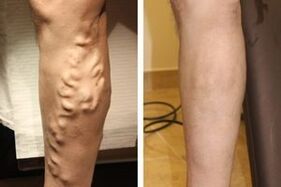
Removal of blood vessels in the lower extremities is called radical treatment. If the use of conservative and alternative therapies does not give the desired therapeutic effect and the disease continues to progress, the patient may be prescribed surgery to remove varicose veins in the legs.
Surgery with an advanced form of varicose veins can solve the following problems:
- Eliminate pathological blood reflux (reverse flow).
- Save the disease-free, healthy parts of the saphenous veins.
- Remove the affected areas of the veins.
Before the operation, the doctor marks the vessels under ultrasound control, which allows you to determine the extent of the affected segment. Removal of affected vessels and vascular sections is performed using a narrow probe inserted through a small incision. The risk of recurrence of the disease is low after removal of the affected area.
There is little chance of recurrence of the disease after surgery to remove varicose veins.
In modern medicine, a combined phlebectomy procedure is preferred, which involves the simultaneous use of several techniques.
The main stages of combined radical treatment are: upper or lower cross-section, short peeling, closure of perforated veins, mini-phlebectomy.
In the early stages of the disease, any of the listed procedures can be used as an independent operation. In some cases, minimally invasive treatments in the form of sclerotherapy or laser obliteration may be offered as an alternative to some stages of classical combined phlebectomy.
Types of operations
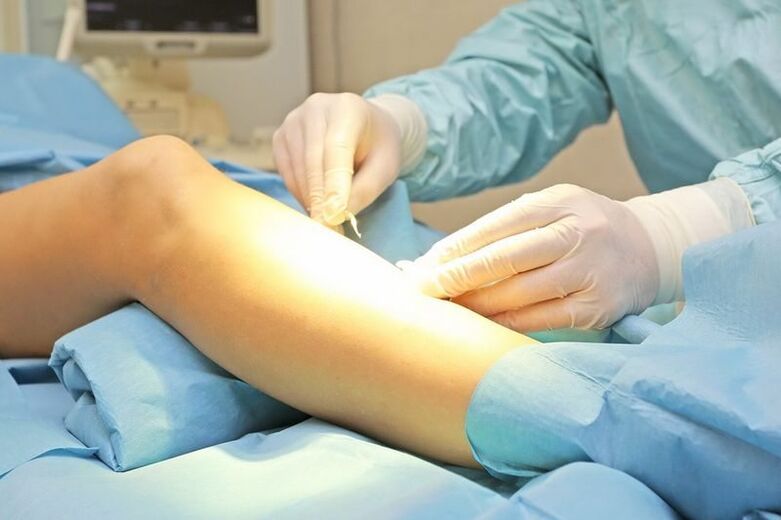
The common name for the operation to remove the affected vessels is phlebectomy. Modern types of this procedure:
- Performing a peeling procedure (long or short) is the most gentle technique, during which the doctor can remove only a certain part of the affected vessel. The procedure is performed with a small incision along the vein.
- Laser phlebectomy is a modern treatment that involves the use of a laser. Thanks to this tool, the process of laser coagulation takes place inside the affected vessels. The procedure is performed under local anesthesia and does not require the use of special surgical instruments. The laser is injected into a vein with a small-diameter catheter, and then small vapor bubbles are formed that affect the walls of the arteries under the influence of the pulse. As a result, the affected vessel becomes part of the tissue and no longer bothers the patient.
- Endoscopic removal of the affected vessel. In this case, an endoscope is inserted into the vascular area, and the doctor can personally analyze its condition and the degree of damage. In the future, the surgeon has the opportunity to cut the affected area.
Seamless technologies are very popular when the affected area of the vein is cut through small incisions. After 4-6 hours of manipulation, the patient can walk independently. When the development of trophic disorders is observed, endoscopic equipment is used.
Advantages of the method of miniphlebectomy
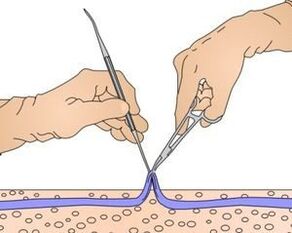
Miniphlebectomy is one of the most painless and non-traumatic methods of surgical removal of affected vessels. The procedure is performed in three stages: diagnosis, a small incision with a scalpel at the site of impaired blood flow, removal of the affected area of the vessel.
The operation is performed under local anesthesia, the rehabilitation period does not take much time from the patient. There are no scars or bruises at the puncture site, and in isolated cases, the pain is uncomfortable.
Miniphlebectomy is an almost painless method to get rid of varicose veins, the recovery time after surgery is minimal.
To minimize the risk of bruising and bruising, the operation can be performed using a swollen anesthetic that contains a vasoconstrictor in addition to the anesthetic. After the procedure, the patient is released home a few hours later, there is no intoxication, which is typical of general anesthesia, as well as pain.
Chaprazectomy
The term "crossectomy" means the closure and subsequent rupture of a small or large saphenous vein. As an independent operation, such a procedure can be performed only in emergencies, when there is a risk of spreading an acute form of thrombosis.
To date, there are milder alternative procedures for crossectomy - endovasal laser ablation and radiofrequency ablation.
The advantages of the technique are: the ability to refuse general anesthesia, outpatient treatment, the absence of cosmetic defects in the form of cuts and scars.
Among the disadvantages is the high probability of recurrence of the disease and the relatively high cost of these procedures.
Training
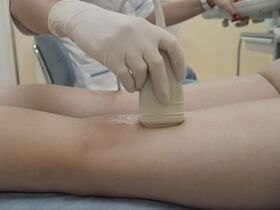
Surgery for varicose veins of the lower extremities is performed after the initial examination of the patient and an internal examination.
The following types of exams can be assigned:
- Ultrasound of the leg vessels.
- General blood test.
In the future, the doctor will conduct an oral survey to determine possible contraindications for surgery. The initial examination allows you to choose the optimal type of surgery or, if necessary, combine several known methods at once.
It is important that the patient understands how to behave properly before and after the procedure. It is recommended to avoid taking acetylsalicylic acid medications before surgery due to the risk of bleeding. On the day of surgery, the procedure does not need to be prepared very carefully - you just need to get rid of the hair in the area of the operated joint.
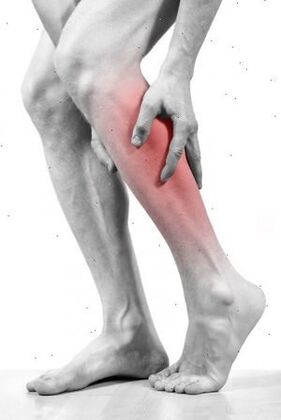
When do you need surgery?
Patients interested in whether surgery is required for lower extremity varicose veins should understand that such a radical therapy is needed in the following cases:
- Rapid development of the disease accompanied by severe pain.
- Development of grade 1-4 varicose thrombophlebitis.
- Strong heat and burning sensation in the vascular region.
- Spread of varicose veins above the knee caps.
- Visible formation of a swollen, aesthetically unattractive vessel.
Surgery is also indicated for the development of long-term incurable trophic disorders (ulcers) where conservative therapy does not provide the required therapeutic effect.
Contraindications and possible consequences

It is necessary to take into account the possible contraindications and consequences of surgery.
If the patient has a history of hypertension, cardiac arrhythmias, coronary heart disease, acute infectious diseases, dermatological inflammatory diseases of the legs, surgery can not be performed.
Surgery should not be performed in late pregnancy, as well as in elderly patients with weakened immunity.
Patients should consider possible complications, as well as the consequences of surgery:
- Impaired sensitivity of the operated joint as a result of nerve ending damage.
- Intermittent or persistent numbness in the ankle area.
- Formation of pus.
- Development of bleeding of varying intensity.
- Re-education of convex vessels in one place above or below the postoperative scars.
- Pain syndrome does not bother all patients and occurs if the nerve endings are affected. Normalization of sensitivity often occurs independently, without the use of any drugs.
- Hematomas and caries in the surgical area may be a concern. In this case, drugs from the group of anticoagulants can be prescribed for topical use. If the patient has very thin and sensitive skin, then the bruises can last 1-1, 5 months.
- The development of edema may indicate that the patient has not followed the doctor's instructions, has not followed the rest regimen, and has subjected the body, including the lower limbs, to excessive physical exertion.
Strictly follow the doctor's recommendations, it depends on how quickly the results of the operation will pass.
Therefore, before deciding whether it is worth surgery for varicose veins, you should consider all possible risk factors: weigh the pros and cons thoroughly. Surgery should be performed in cases where the manifestations of the disease bother patients for a long time and significantly worsen the quality of life.
It is also necessary to consult only experienced and qualified doctors who perform such operations: phlebologists, angiosurgeons.
Recovery time

After the operation, the patient is advised to follow all the instructions of the attending physician, so that the recovery period is as short as possible and you can quickly return to your normal lifestyle. During the first 48 hours, patients are strictly prohibited from:
- Use of alcohol.
- Motor vehicle management.
- Take a hot bath.
- Excessive physical activity.
In the first days after surgery, there may be complaints of pain in the legs, as well as an increase in body temperature. In this case, medical methods of treatment are involved, physiotherapy is prescribed. The patient should not always be in a horizontal position. You need to walk a little every day to restore blood flow.

Implementing the following recommendations in the future will also minimize the risk of developing postoperative complications.
- Hydroprosurgery, massage, therapeutic exercises and other methods of physiotherapy to be prescribed by the attending physician. Such procedures prevent the formation of blood clots, normalize blood flow.
- For the first few months, both limbs should be re-wrapped with special elastic underwear or compression stockings.
- Use drugs from the group of phlebotonics, angioprotectors. With the development of inflammatory processes, antibacterial drugs can be prescribed. Painkillers are used to relieve pain.
- When stitches are made, they can be removed 7 days after the operation.
- If the patient is overweight, it is necessary to bring him back to normal to reduce the load on the arteries.
- It is recommended to prefer loose clothes and comfortable shoes made of natural fabrics. Wearing high heels is contraindicated.
- At home, you should try to keep your feet high using rolls or pillows.
The rehabilitation period can last up to several weeks, during which time the patient is given special sick leave.
Modern methods of removing varicose veins involve only a few days of rehabilitation, but they are more expensive than usual.
In the future, the patient should come for a second examination and undergo an additional examination to assess the effectiveness of treatment.
Operating cost
Phlebectomy is performed in both public clinics and plastic surgery centers, the purpose of which is to eliminate aesthetic defects.
Patients are interested in how much the operation of varicose veins costs.
It all depends on the clinic and the specialty of the doctor performing the procedure, as well as the degree of development of the disease and the complexity of the proposed operation. The last place in the formation of prices is not given to the city and region where the patient intends to perform the procedure.
A number of clinics include preoperative examination as well as cost-effective rehabilitation.
Expert forecasts

Performing a combined phlebectomy procedure does not exclude the possibility of recurrence of the disease. Recurrence of varicose veins is possible after the use of radical treatments due to physiological features of the body (structure of blood vessels and vessels) or violation of the technique of the procedure (if the doctor can not do it). normalizes the patency of the affected vessel). The risk of recurrence is about 15-20%. If the patient notices recurrent manifestations of the disease, you should consult a doctor as soon as possible.
Only an experienced specialist will help you correctly suggest which operation to choose to remove varicose veins, as well as give useful recommendations to be followed during the recovery period. If you do not consult a doctor in time, the results can be the most tragic and irreversible.


















